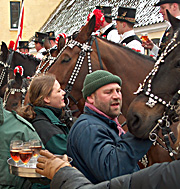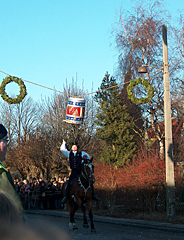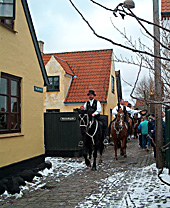The
Danish Shrovetide celebrations have developed in mysterious ways over
the centuries. On the island of Amager, just around Copenhagen Airport,
many of the older traditions have been preserved and draw thousands of
spectators each year. Dragør, once a fishing and trading port,
really goes to town, as does in Store Magleby, and the little village
Ullerup only a few kilometers outside Copenhagen.
In Dragør on Shrovetide Sunday, in Store Magleby on Shrovetide
Monday and in Ullerup on Shrovetide Wednesday, the day-long festivities
begin as horseriders gather to parade, led by flagmen and a carriage full
of musicians. They all wind their way throughout the district, where they
are served hot rum punch in exchange for a song. Later in the afternoon
the mounted assembly meets for tilting the barrel.
"Knights" dressed in top hats, ornate white shirts and black
embroidered vests manoeuvre their steeds at full gallop and swing carved
batons at a barrel hung from a rope between two poles. When the final
stave has been bashed from the barrel, the gathering elects a Barrel King
and Queen. The rider who beats the last barrel stave down is elected Barrel
King of the year and receives a wreath and a kiss from the Barrel Queen.
The couple open the festive Barrel Ball and Fastelavn extends long into
night.
Children always jump out of bed excitedly on this morning, as under their
beds the lucky ones find a Fasterlavnsris, a small cluster of twigs decorated
with coloured paper and sweets.These weapon are used for waking up their
parents. Later they are "knocking the cat out of the barrel"
– the children's version of the adult celebrations. Princesses, fairies,
pirates and the rest use all their strength to splinter the barrel (at
school or elsewhere) and spill the toys and sweets inside. The lucky child
who manages it becomes the Cat King or Queen of Fastelavn.
Fastelavn Sunday falls in the uncertain period between winter and spring,
and was once regarded as a fertility rite. Like Mardi Gras it was the
final feast before the 40-day Lenten fast preceding Easter. Centuries
ago, peasants would gather at a farm to feast, sometimes naked, since
fertility rites often involved sowing seeds in the nude to ensure a good
crop. Strangely, ladies would also hike their skirts to reveal their bare
bottoms for the sake of fertility! In the 16th century, Danish rulers
attempted to abolish such "debauchery" and some traditions were
lost, although the spirit of Fastelavn has survived.




